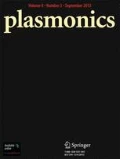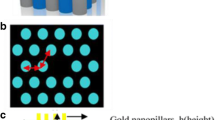Abstract
Surface-enhanced Raman scattering (SERS) is a very promising detection/diagnostic technique at trace levels as the molecules exhibit a significant increase in their Raman signals when they are attached or are in proximity to plasmonic structures. In this study, a numerical design of SERS substrate as a probe has been demonstrated for detection and diagnosis of blood, water and urea samples. The proposed nanospiral design is polarization independent, and it offers the enhancement of the electric field strength ~ 109. The substrate design is based on 3D finite difference time domain simulations and is robust, versatile and sensitive even at low concentrations of the analyte. It works equally well when used in the reflection mode. In this study, the cavity quantum electrodynamics (CQED) Purcell factor has also been transposed to plasmonics. The Purcell factor in corroboration with CQED has been used to achieve efficient light–matter interaction at nanoscale by providing a more realistic result. It takes into account the randomness of incident wave polarizations and arbitrary orientations of interacting molecules. This gives a deeper insight into electromagnetic Raman gain in SERS and can be used to design novel SERS substrates.







Similar content being viewed by others
Availability of Data and Materials
The data that support the findings of this study are available from the corresponding author upon reasonable request.
References
Moskovits M (2005) Surface-enhanced Raman spectroscopy: a brief retrospective. J Raman Spectrosc 36(6–7):485–496
Nie S, Emory SR (1997) Probing single molecules and single nanoparticles by surface-enhanced Raman scattering. Sci 275(5303):1102–1106
Kneipp J, Kneipp H, Kneipp K (2008) SERS—a single-molecule and nanoscale tool for bioanalytics. Chem Soc Rev 37(5):1052–1060
Kneipp K et al (1997) Single molecule detection using surface-enhanced Raman scattering (SERS). Phys Rev Lett 78(9):1667–1670
Dasary SSR, Singh AK, Senapati D, Yu H, Ray PC (2009) Gold nanoparticle based label-free SERS probe for ultrasensitive and selective detection of trinitrotoluene. J Am Chem Soc 131(38):13806–13812
Goel R, Awasthi V, Rai P, Dubey SK (2020) Numerical design of photonic crystal-based nanostructured substrate for efficient surface-enhanced Raman scattering. Plasmonics 1–8
Liu B, Zhou P, Liu X, Sun X, Li H, Lin M (2013) Detection of pesticides in fruits by surface-enhanced Raman spectroscopy coupled with gold nanostructures. Food Bioprocess Technol 6(3):710–718
Baniukevic J, Boyaci IH, Bozkurt AG, Tamer U, Ramanavicius A, Ramanaviciene A (2013) Magnetic gold nanoparticles in SERS-based sandwich immunoassay for antigen detection by well oriented antibodies. Biosens Bioelectron 43(1):281–288
Keith C, Laura P, Mary L (1992) Octadecylthiol-modified surface-enhanced Raman spectroscopy substrates: a new method for the detection of aromatic compounds. Environ Sci Technol 26(10):1950–1954
Vendrell M, Maiti KK, Dhaliwal K, Chang YT (2013) Surface-enhanced Raman scattering in cancer detection and imaging. Trends Biotechnol 31(4):249–257
Kimble HJ, Polzik E, Rempe G, Thompson RJ (1992) Structure and dynamics in cavity quantum electrodynamics. In: Ippen E, Chu S, Shah J, Weiman C (eds) Quantum Electronics and Laser Science Conference, OSA Technical Digest Optical Society of America, pp 13
Purcell EM (1995) Spontaneous emission probabilities at radio frequencies. Springer, Boston, MA, pp 839–839
Matsko AB, Savchenkov AA, Letargat RJ, Ilchenko VS, Maleki L (2003) On cavity modification of stimulated Raman scattering. J Opt B Quantum Semiclassical Opt 5(3):272–278
Buckley S, Rivoire K, Vučković J (2012) Engineered quantum dot single-photon sources. Rep Prog Phys 75(12):126503
Agio M (2012) Optical antennas as nanoscale resonators. Nanoscale 4(3):692–706
Tame MS, McEnery KR, Özdemir SK, Lee J, Maier SA, Kim MS (2013) Quantum plasmonics. Nat Phys 9(6):329–340
Hakami J, Wang L, Zubairy MS (2014) Spectral properties of a strongly coupled quantum-dot-metal-nanoparticle system. Phys Rev A Atomic Mol Opt Phys 89(5):053835
Rousseaux B, Dzsotjan D, Francs GCD, Jauslin HR, Couteau C, Guérin S (2016) Adiabatic passage mediated by plasmons: a route towards a decoherence-free quantum plasmonic platform. Phys Rev B 93(4):045422
Jackson JB, Halas NJ (2004) Surface-enhanced Raman scattering on tunable plasmonic nanoparticle substrates. Proc Natl Acad Sci USA 101(52):17930–17935
Freeman RG et al (1995) Self-assembled metal colloid monolayers: an approach to SERS substrates. Sci 267(5204):1629–1632
Wang H, Levin CS, Halas NJ (2005) Nanosphere arrays with controlled sub-10-nm gaps as surface-enhanced Raman spectroscopy substrates. J Am Chem Soc 127(43):14992–14993
Ko H, Singamaneni S, Tsukruk VV (2008) Nanostructured surfaces and assemblies as SERS media. Small 4(10):1576–1599
Banholzer MJ, Millstone JE, Qin L, Mirkin CA (2008) Rationally designed nanostructures for surface-enhanced Raman spectroscopy. Chem Soc Rev 37(5):885–897
Camden JP, Dieringer JA, Zhao J, Van Duyne RP (2008) Controlled plasmonic nanostructures for surface-enhanced spectroscopy and sensing. Acc Chem Res 41(12):1653–1661
Awasthi V, Goel R, Agarwal S, Rai P, Dubey SK (2020) Optical nanoantenna for beamed and surface-enhanced Raman spectroscopy. J Raman Spectrosc 1–25
Ni X, Wang L, Zhu J, Chen X, Lu W (2017) Surface plasmons in a nanostructured black phosphorus flake. Opt Lett 42:2659–2662
Tang W, Wang L, Chen X, Liu C, Yu A, Lu W (2016) Dynamic metamaterial based on the graphene split ring high-Q Fano-resonator for sensing applications. Nanoscale 8(33):15196–15204
Wang L, Chen X, Yu A et al (2014) Highly sensitive and wide-band tunable terahertz response of plasma waves based on graphene field effect transistors. Sci Rep 4:5470
Lee T, Kwon S, Lee JJ (2020) Highly dense and accessible nanogaps in Au-Ag alloy patterned nanostructures for surface-enhanced Raman spectroscopy analysis. ACS Appl Nano Mater 3(6):5920–5927
Zheng P, Li M, Jurevic R, Cushing SK, Liu Y, Wu N (2015) A gold nanohole array based surface-enhanced Raman scattering biosensor for detection of silver(i) and mercury(ii) in human saliva. Nanoscale 7(25):11005–11012
Zhang W et al (2020) Arrayed nanopore silver thin films for surface-enhanced Raman scattering. RSC Adv 10(40):23908–23915
Osminkina LA et al (2020) Gold nanoflowers grown in a porous Si/SiO2 matrix: the fabrication process and plasmonic properties. Appl. Surf, Sci, p 507
Kerker M, Wang DS, Chew H (1980) Surface enhanced Raman scattering (SERS) by molecules adsorbed at spherical particles: errata. Appl Opt 19(24):4159
Nanophotonic FDTD Simulation Software - Lumerical FDTD. https://www.lumerical.com/tcadproducts/fdtd
Palik ED (1985) Handbook of optical constants of solids. Academic Press Inc, San Diego
Johnson PB, Christy RW (1972) Optical constants of the noble metals. Phys Rev B 6:4370
Sardar D, Levy L (1998) Optical properties of whole blood. Lasers Med Sci 13:106–111
Taflove A, Hegnese SC (1998) Computational electrodynamics: the finite-difference time-domain method. Artech House, Boston, Mass, USA
Ogarev VA, Rudoi VM, Dement’eva OV (2018) Gold nanoparticles: synthesis, optical properties, and application. Inorg Mater Appl Res 9:134–140
Maier SA (2006) Plasmonic field enhancement and SERS in the effective mode volume picture. Opt Express 14(5):1957
Sun G, Khurgin JB (2012) Origin of giant difference between fluorescence, resonance, and nonresonance Raman scattering enhancement by surface plasmons. Phys Rev A 85(6):63410
Maslovski SI, Simovski CR (2019) Purcell factor and local intensity enhancement in surface-enhanced Raman scattering. Nanophotonics 8(3):429–434
Funding
The authors were financially assisted by the Department of Science and Technology, Delhi, Government of India, Project No. RP03496.
Author information
Authors and Affiliations
Corresponding author
Ethics declarations
Conflict of Interest
The authors declare that they have no conflict of interest.
Additional information
Publisher’s Note
Springer Nature remains neutral with regard to jurisdictional claims in published maps and institutional affiliations.
Rights and permissions
About this article
Cite this article
Goel, R., Awasthi, V., Rai, P. et al. Design of Polarization Independent SERS Substrate with Raman Gain Evaluated Using Purcell Factor. Plasmonics 16, 1365–1373 (2021). https://doi.org/10.1007/s11468-021-01410-z
Received:
Accepted:
Published:
Issue Date:
DOI: https://doi.org/10.1007/s11468-021-01410-z




